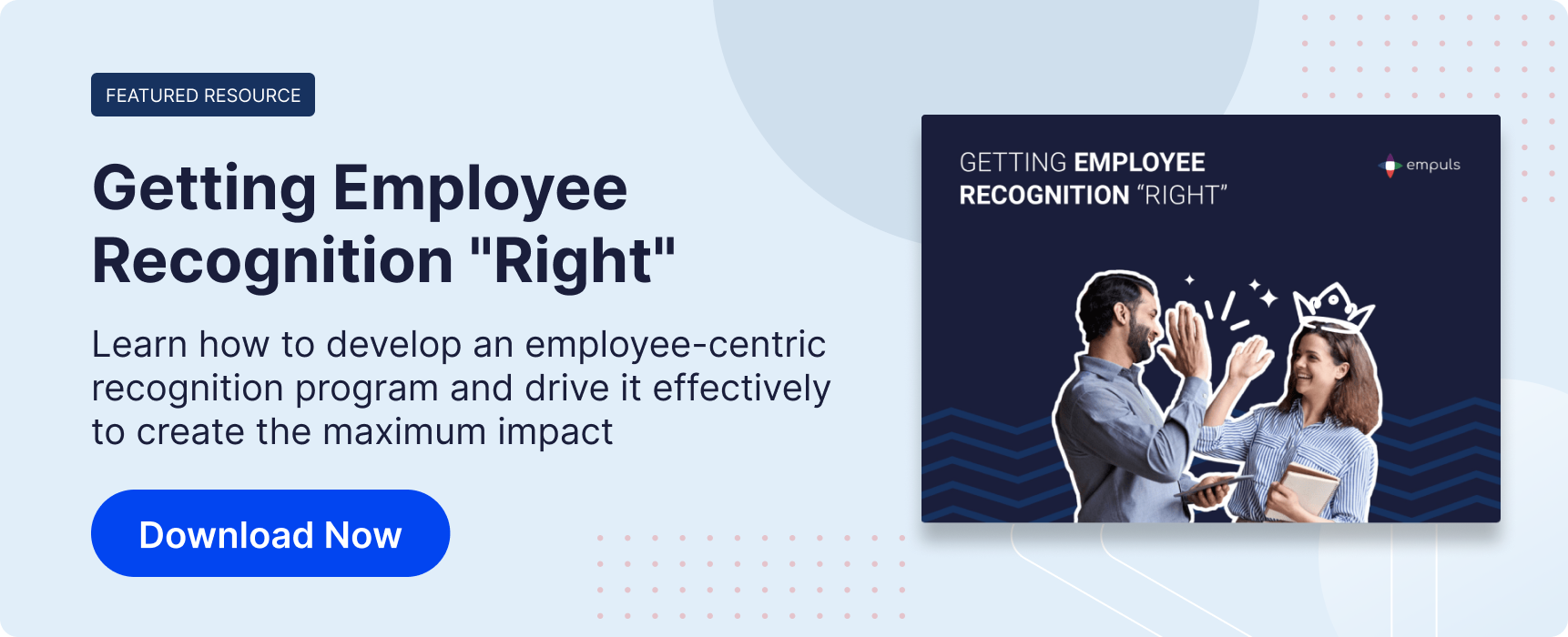On this page
Companies are always looking for ways to improve their overall productivity and bottom-line. Employee recognition remains an important business strategy that every company needs to consider, and I'll tell you why.
This implies that companies that do not recognize their employees will most likely suffer high turnover costs—ranging from 5.8 percent up to 213 percent of an employee's salary, depending on the job and employee skills.
Besides the direct replacement costs, other associated costs include lost productivity and time, temporary coverage, and new employee training.
Think about what those costs would look like if more than one employee left the company! This is why HR and business leaders need to pay more attention to employee recognition statistics.
We have compiled a list of key employee recognition statistics that every HR leader should know. You will find the information helpful as you make the business case for your company's employee recognition program.
Employee recognition statistics clearly justify why it is important to have different categories of rewards and recognition for employees in your company.
10 Key employee recognition statistics
To make things easier for you, we have compiled a list of the top 10 key employee recognition statistics that you must know.
Let’s dive in.
1. Over a third of all respondents said their job was a regular source of stress.
The workplace can cause significant stress for many workers. Among millennials and Gen Zers, the chronically work-stressed population rises to 44 percent.
Excessive stress can, in turn, lead to burnout, which costs the global economy approximately £255 billion.
Knowing these facts, companies can improve employees' mental health by creating a recognition culture and focusing on wellbeing initiatives as part of their total rewards package.
Employee recognition helps to motivate employees and foster a sense of pride and gratitude in them. Consequently, employees feel happier and are productive in the workplace.
2. Globally, one in four employees strongly agrees that they have received recognition or praise for doing good work in the last week.
Note that one of Gallup's Q12 employee recognition survey questions asks if the respondent has received praise in the last seven days.
According to best practices, employee recognition should be frequent and given on time. If you lead a 10-person team, this employee recognition statistic shows that at least two employees have received recognition for doing good work in the last seven days.
The danger of not recognizing your employees, according to Gallup, is that "employees who do not feel adequately recognized are twice as likely to say they'll quit in the next year."
Therefore, it is crucial to regularly recognize your employees and peers for their meaningful contributions to the workplace.
3. According to a report on employee recognition stats, 56 percent of HR professionals agreed that their recognition program has a positive impact on recruitment.
When a company creates a positive culture for existing employees, one where they are recognized for their contributions, employees will help publicize their company as a great place to work.
Often, exceptional candidates choose to work for a company based on factors beyond compensation—they evaluate its values, mission, and other cultural elements.
Since people are four times more likely to buy [your brand] when referred by friends, a positive reputation can make it easier to attract top-tier candidates to your company.
As a result, companies will be saving time and cost in their recruitment efforts.
4. 27 percent of employees in different countries point to a lack of recognition and rewards as an important reason to leave an employer.
In their 2018 global report, Randstad presented important insights from a survey of over 175,000 respondents in 30 countries.
According to this report, one of the factors driving employees away from companies is the lack of recognition and rewards.
Clearly, employee recognition is a retention strategy, and employees who feel valued will remain at their jobs. Also, global recognition programs bring out the best in people and motivate them to perform better in their roles.
Companies struggling to retain employees need to consider creative ways to recognize their employees and ensure that there are opportunities for employees' professional development.
5. Employee engagement, productivity, and performance are 14 percent higher than in organizations without recognition.
58 percent of HR professionals recommend that leaders recognize and praise their employees more often to help drive engagement.
In other words, employee recognition is a win-win for everyone. Employees experience a boost in morale and are motivated to improve their work performance, while the company experiences an overall improvement in performance.
6. 79 percent of millennials say that an increase in recognition would make them more loyal to their employer.
Many millennials grew up receiving constant praise from their parents, showing that they were making progress and doing something meaningful.
Millennials' expectation of regular praise isn't any different in the workplace. Millennials want to know that their contributions matter and they expect to receive immediate recognition for doing them.
However, most millennials are not happy with their companies' rewards and recognition programs. This means that the traditional or one-size-fits-all approach to employee recognition is not the right approach to use with millennials.
To attract millennials and retain them for a while, ensure that they are doing meaningful work and receive instant and regular feedback and recognition for their contributions.
7. 28 percent of workers revealed that the most memorable recognition comes from their managers.
According to Gallup’s employee recognition survey, 28 percent of respondents agreed that their most memorable recognition came from their managers. In comparison, 24 percent agreed that theirs came from the CEO or a high-level leader.
The analysis adds that "employees will remember personal feedback from the CEO… In fact, acknowledgement from a CEO could become a career highlight." Going by this information, one would lean in favor of the manager-employee recognition structure.
However, it is important to make employee recognition multidirectional—from business leaders, managers, peers, or direct reports. It allows for an opportunity to get rounded feedback from everyone the employee works closely with, including external parties.
8. Nearly 90 percent of employees who received recognition or thanks from their boss in the past month indicated higher trust levels in that boss.
When leaders recognize employees for their contributions, they are positively reinforcing the desired behaviors, making them feel appreciated, and creating an environment of trust.
Also, trust matters in the workplace because it makes employees more innovative and productive—they can give their best performance, which ultimately improves the bottom line.
9. According to a report on employee appreciation, 85 percent of professionals want to hear "thank you" in day-to-day interactions.
Appreciation plays a huge role in engaging employees. According to insights from Deloitte's Business Chemistry, "today's employees want a relationship with their employer that is personalized, flexible, and customized, and they want to feel appreciated and valued for what they do."
Saying "thank you" is a simple way to appreciate an employee in the workplace—and it can be expressed through cards, messages, gifts, or gift cards.
10. Many remote workers—even while still employed—are likely to feel adrift, lost, forgotten in their new work environment.
Before the pandemic, many remote workers had reported feeling left out and unrecognized by their counterparts in the office.
However, due to the pandemic, the percentage of full-time employees working from home has increased globally. It is not surprising that many remote workers are feeling forgotten.
Employers can address this issue by offering simple ways for employees to recognize each other's contributions and leveraging technology platforms to make it a democratic, frictionless and transparent process.
Final Thoughts
Hopefully, you have found these employee recognition stats useful in understanding the importance of employee recognition and helping you design a good employee recognition program that can impact your company's financial results.
















